How to add Google Analytics 4 in WordPress
Need to update to Google Analytics 4, but not sure how? Having a hard time setting up Google Analytics 4 that you need now? In this article, I'll show you how.

Google Analytics 4 is replacing its predecessor, Universal Analytics, which will stop collecting data in July 2023 (July 2024 for Google Analytics 360 customers). For non-360 customers, switching to GA4 is mandatory, so it's important to start now.
don’t worry! This practical guide will give you step-by-step instructions on how to easily install and activate GA4 on your WordPress website. Let's get started updating your old Google Analytics.
Install and activate the Google Analytics for WordPress plugin
The first step in setting up Google Analytics 4 on your website is to install a WordPress plugin that adds the Google Analytics tracking code to your website.
To do this, navigate to the Plugins section in your WordPress dashboard, click Add New, and search for Google Analytics .
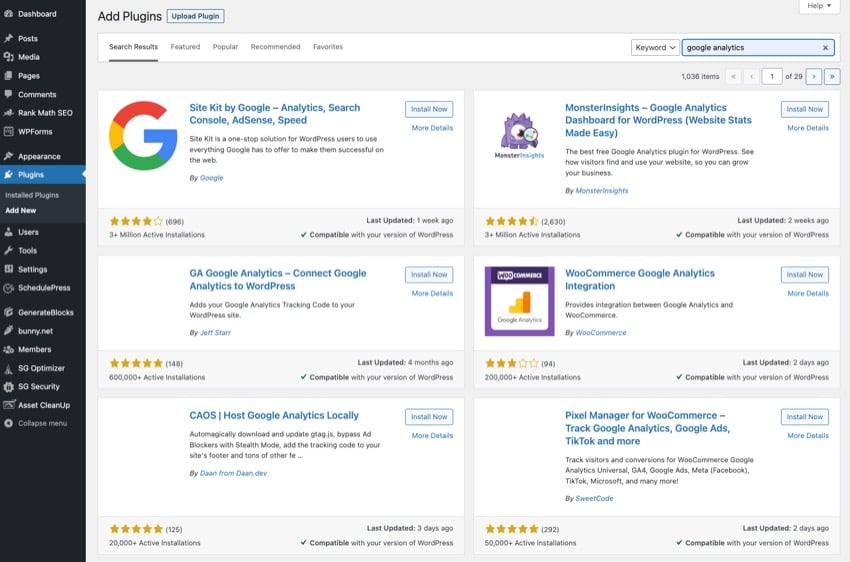
From the search results, find GA Google Analytics or MonsterInsights, which are widely recommended plugins due to their seamless integration with Google Analytics 4 Famous for WordPress integration.
Select Install now, then click to activate.
You have now successfully installed and activated the Google Analytics plugin and are ready to set it up.
Create a Google Analytics 4 Property
When transitioning from Universal Analytics to GA, you must create a new Google Analytics 4 property for your WordPress site. Here are step-by-step instructions.
Visit the Google Analytics website and click Manage in the lower left corner of your account.

Select your account in the Account column of the Admin console. Then go to the Properties column and click Create Property.
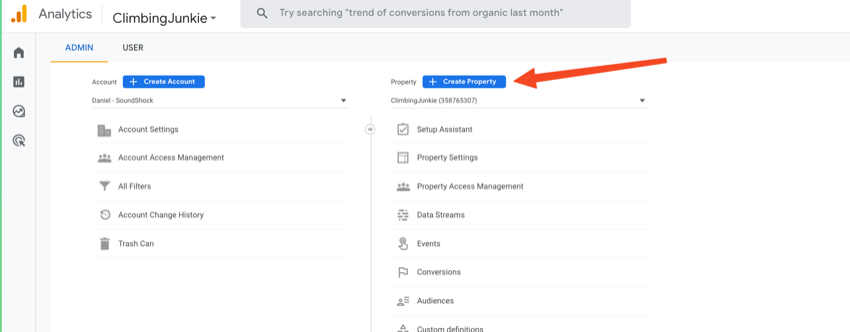
Name your new property after your WordPress site, then fill out the Business Details and Business Goals pages.
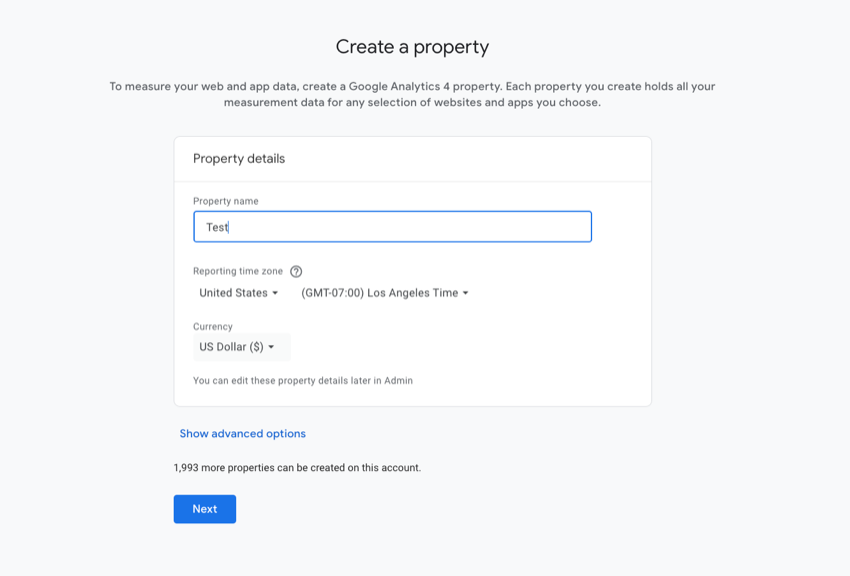
On the final settings screen, click Web as your platform. Enter the details of your WordPress site, including the URL under Website URL and the site name.
Click Create and, if necessary, accept the terms of the service agreement.
Your Google Analytics 4 property is now set up and ready to collect data.
Get Google Analytics 4 Measurement ID
Now that you have set up your Google Analytics property, you must obtain your measurement ID.
Click the Manage button in the lower left corner of the Google Analytics screen.
Under the Properties column, select Data Flow.
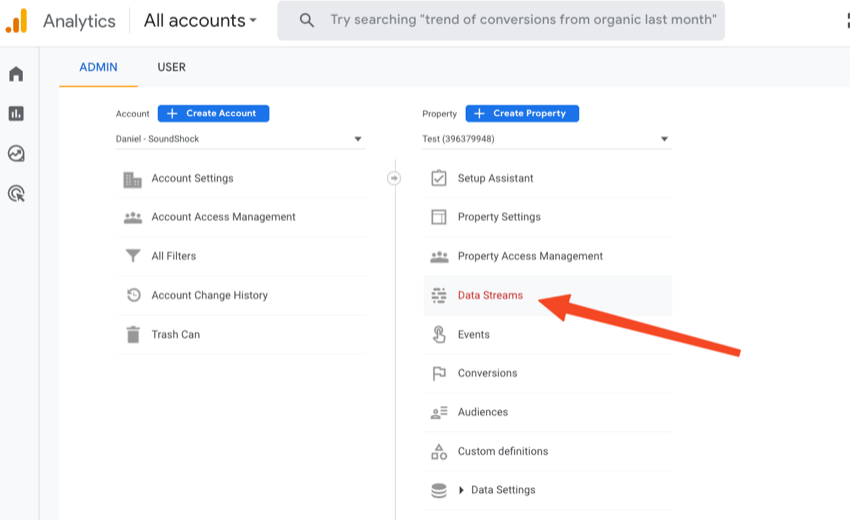
Select the Web option and select the properties you just set. A panel will appear with all the information about the stream, including the measurement ID.
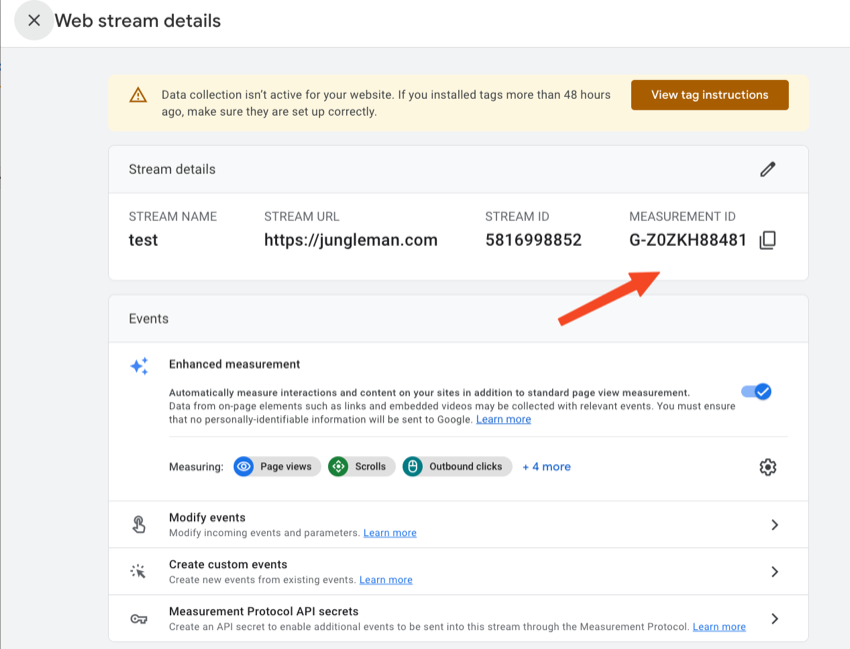
Copy the measurement ID as needed to configure the Google Analytics WordPress plugin.
Configure Google Analytics for WordPress plugin
To configure the Google Analytics for WordPress plugin, follow these steps:
Go to the Settings menu in your WordPress dashboard and click Google Analytics.
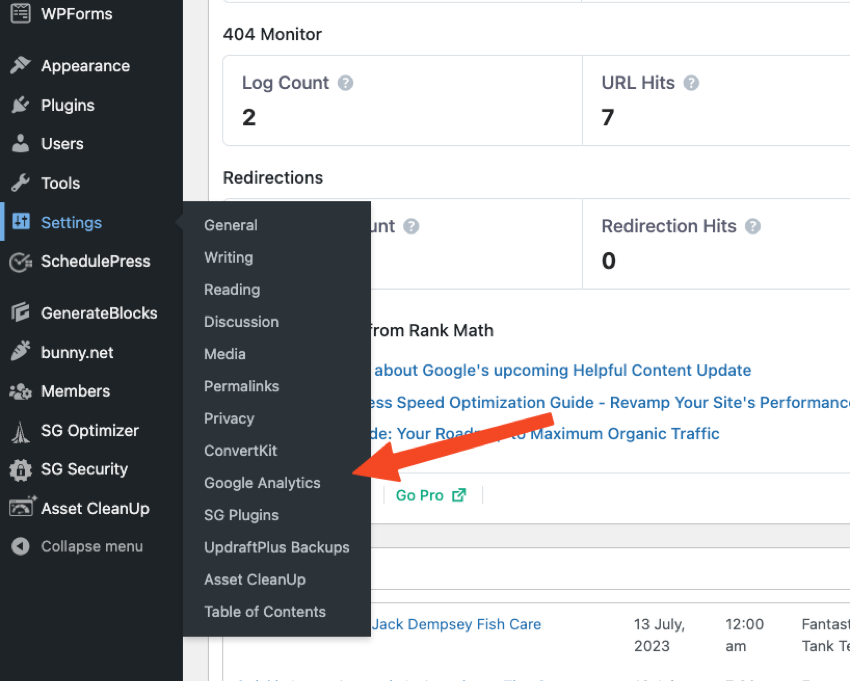
Enter your GA4 Measurement ID in the GA Tracking ID section.
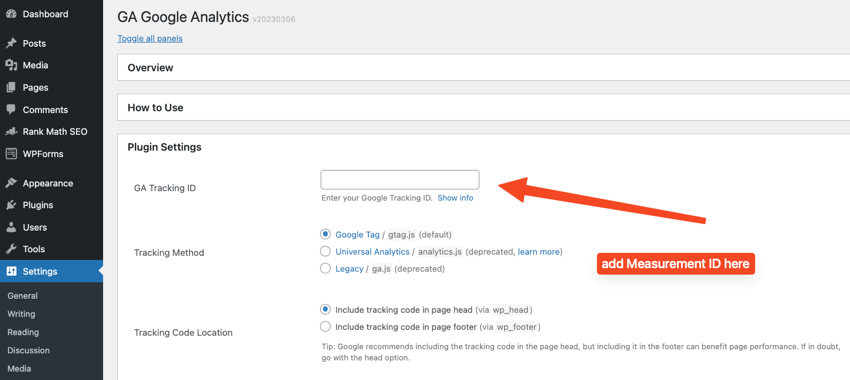
Next, select a tracking method Google Tag in the section below.
Finally, click the Disable tracking for admin-level users section so that Google Analytics will not track your admin activity.

Save changes and exit setup.
Now it’s time to verify that Google Analytics 4 is running on your WordPress site.
Verify Google Analytics 4 Tracking on WordPress
To ensure that Google Analytics 4 (GA4) is set up and tracked correctly on your WordPress site, you can verify this in a few ways:
Verify installation using real-time reporting
Open your website in a new browser tab.
Go back to your Google Analytics account and navigate to Real-Time Reports.
Find the Overview report and check if your site appears in the Current Active Users section. If you see active users on your site, it means GA4 is tracking your site.
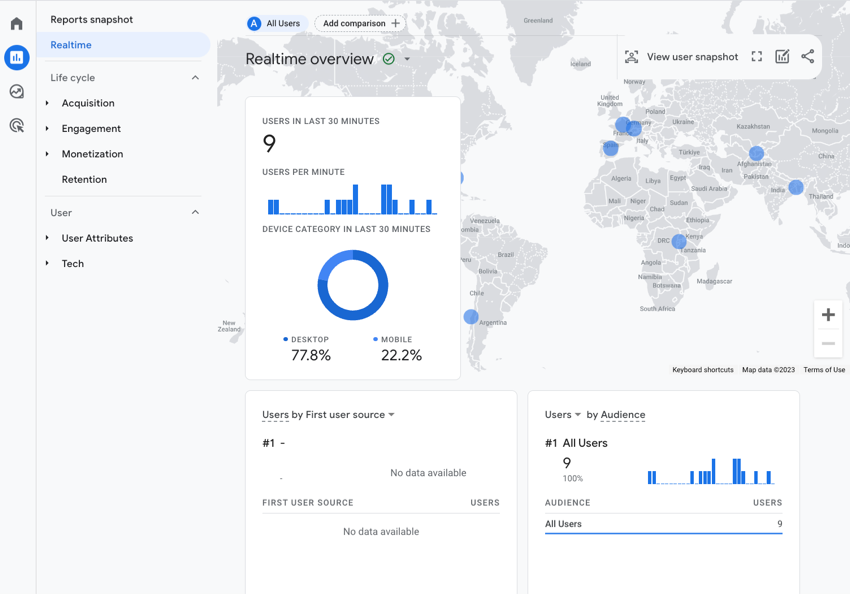
Using the DebugView function
Open your website in a new browser tab.
Add the following to the end of the website URL, ?debug_mode=true.

Next, open your browser's developer console by right-clicking and selecting Inspect or by pressing F12.
Look for the Google Analytics DebugView panel in the console and check for any error messages or warnings related to GA4. If there are no errors or warnings, GA4 is functioning properly.
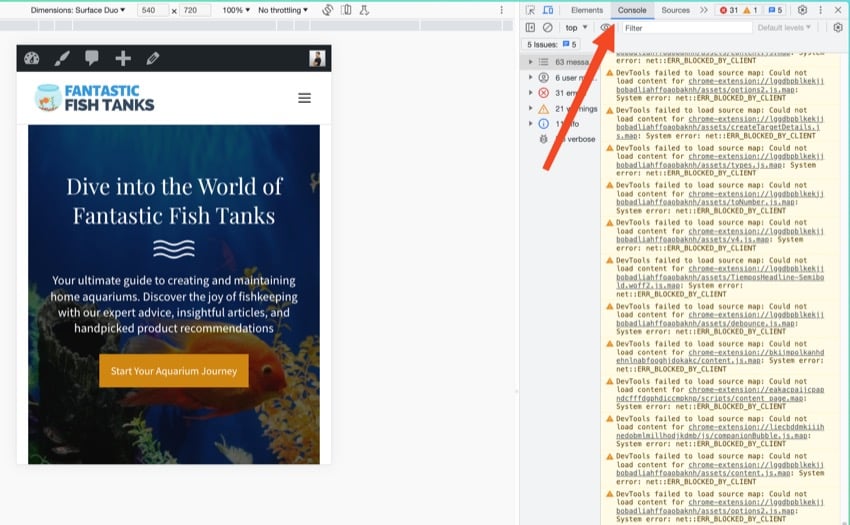
Download High Quality WordPress Plugin
Looking to take your WordPress website to the next level? WordPress plugins are an invaluable tool for all WordPress website owners. They provide your website with important features you need to run a successful website, which a new WordPress website does not have.
Check out the resources below for tons of great plugins you can download for your WordPress site today!
Unleash the power of Google Analytics 4 for your WordPress website
Adding Google Analytics 4 to your WordPress website is a simple process that can provide valuable insights into your website performance. By following the steps outlined in this guide and using the available plugins, you can easily configure GA4 tracking and take advantage of its powerful features.
With GA4, you'll have access to rich customer data and enhanced marketing capabilities to optimize your ads and improve your overall online presence. So don’t miss this opportunity to realize the full potential of your WordPress website with Google Analytics 4!
If you need more high-quality plugins and themes for your WordPress site, use Envato Elements. You can access thousands of WordPress resources for a low monthly fee.
The above is the detailed content of How to add Google Analytics 4 in WordPress. For more information, please follow other related articles on the PHP Chinese website!

Hot AI Tools

Undresser.AI Undress
AI-powered app for creating realistic nude photos

AI Clothes Remover
Online AI tool for removing clothes from photos.

Undress AI Tool
Undress images for free

Clothoff.io
AI clothes remover

Video Face Swap
Swap faces in any video effortlessly with our completely free AI face swap tool!

Hot Article

Hot Tools

Notepad++7.3.1
Easy-to-use and free code editor

SublimeText3 Chinese version
Chinese version, very easy to use

Zend Studio 13.0.1
Powerful PHP integrated development environment

Dreamweaver CS6
Visual web development tools

SublimeText3 Mac version
God-level code editing software (SublimeText3)

Hot Topics
 1387
1387
 52
52
 Is WordPress easy for beginners?
Apr 03, 2025 am 12:02 AM
Is WordPress easy for beginners?
Apr 03, 2025 am 12:02 AM
WordPress is easy for beginners to get started. 1. After logging into the background, the user interface is intuitive and the simple dashboard provides all the necessary function links. 2. Basic operations include creating and editing content. The WYSIWYG editor simplifies content creation. 3. Beginners can expand website functions through plug-ins and themes, and the learning curve exists but can be mastered through practice.
 How To Begin A WordPress Blog: A Step-By-Step Guide For Beginners
Apr 17, 2025 am 08:25 AM
How To Begin A WordPress Blog: A Step-By-Step Guide For Beginners
Apr 17, 2025 am 08:25 AM
Blogs are the ideal platform for people to express their opinions, opinions and opinions online. Many newbies are eager to build their own website but are hesitant to worry about technical barriers or cost issues. However, as the platform continues to evolve to meet the capabilities and needs of beginners, it is now starting to become easier than ever. This article will guide you step by step how to build a WordPress blog, from theme selection to using plugins to improve security and performance, helping you create your own website easily. Choose a blog topic and direction Before purchasing a domain name or registering a host, it is best to identify the topics you plan to cover. Personal websites can revolve around travel, cooking, product reviews, music or any hobby that sparks your interests. Focusing on areas you are truly interested in can encourage continuous writing
 What is the WordPress good for?
Apr 07, 2025 am 12:06 AM
What is the WordPress good for?
Apr 07, 2025 am 12:06 AM
WordPressisgoodforvirtuallyanywebprojectduetoitsversatilityasaCMS.Itexcelsin:1)user-friendliness,allowingeasywebsitesetup;2)flexibilityandcustomizationwithnumerousthemesandplugins;3)SEOoptimization;and4)strongcommunitysupport,thoughusersmustmanageper
 Can I learn WordPress in 3 days?
Apr 09, 2025 am 12:16 AM
Can I learn WordPress in 3 days?
Apr 09, 2025 am 12:16 AM
Can learn WordPress within three days. 1. Master basic knowledge, such as themes, plug-ins, etc. 2. Understand the core functions, including installation and working principles. 3. Learn basic and advanced usage through examples. 4. Understand debugging techniques and performance optimization suggestions.
 How much does WordPress cost?
Apr 05, 2025 am 12:13 AM
How much does WordPress cost?
Apr 05, 2025 am 12:13 AM
WordPress itself is free, but it costs extra to use: 1. WordPress.com offers a package ranging from free to paid, with prices ranging from a few dollars per month to dozens of dollars; 2. WordPress.org requires purchasing a domain name (10-20 US dollars per year) and hosting services (5-50 US dollars per month); 3. Most plug-ins and themes are free, and the paid price ranges from tens to hundreds of dollars; by choosing the right hosting service, using plug-ins and themes reasonably, and regularly maintaining and optimizing, the cost of WordPress can be effectively controlled and optimized.
 Should I use Wix or WordPress?
Apr 06, 2025 am 12:11 AM
Should I use Wix or WordPress?
Apr 06, 2025 am 12:11 AM
Wix is suitable for users who have no programming experience, and WordPress is suitable for users who want more control and expansion capabilities. 1) Wix provides drag-and-drop editors and rich templates, making it easy to quickly build a website. 2) As an open source CMS, WordPress has a huge community and plug-in ecosystem, supporting in-depth customization and expansion.
 Is WordPress still free?
Apr 04, 2025 am 12:06 AM
Is WordPress still free?
Apr 04, 2025 am 12:06 AM
The core version of WordPress is free, but other fees may be incurred during use. 1. Domain names and hosting services require payment. 2. Advanced themes and plug-ins may be charged. 3. Professional services and advanced features may be charged.
 Why would anyone use WordPress?
Apr 02, 2025 pm 02:57 PM
Why would anyone use WordPress?
Apr 02, 2025 pm 02:57 PM
People choose to use WordPress because of its power and flexibility. 1) WordPress is an open source CMS with strong ease of use and scalability, suitable for various website needs. 2) It has rich themes and plugins, a huge ecosystem and strong community support. 3) The working principle of WordPress is based on themes, plug-ins and core functions, and uses PHP and MySQL to process data, and supports performance optimization.




